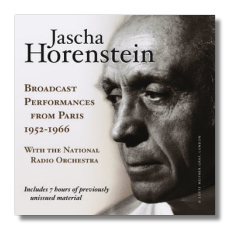
The Internet's Premier Classical Music Source
Related Links
- Latest Reviews
- More Reviews
-
By Composer
-
Collections
DVD & Blu-ray
Books
Concert Reviews
Articles/Interviews
Software
Audio
Search Amazon
Recommended Links
Site News
 CD Review
CD Review
Jascha Horenstein
Broadcast Performances From Paris, 1952-1966

- Samuel Barber: Violin Concerto 1
- Béla Bartók: Concerto for Orchestra
- Ludwig van Beethoven:
- Symphony #1
- Symphony #7
- Symphony #8
- Symphony #9 2
- Egmont Overture
- Johannes Brahms:
- Symphony #1
- Tragic Overture
- Claude Debussy: La Mer
- Franz Joseph Haydn: Symphony #100 ("Military")
- Leoš Janáček: Sinfonietta
- Gustav Mahler: Kindertotenlieder 3
- Felix Mendelssohn: Symphony #4 ("Italian")
- Wolfgang Mozart: Don Giovanni: Overture
- Serge Prokofieff: Symphony #5
- Maurice Ravel:
- Boléro
- Piano Concerto in G Major 4
- Albert Roussel: Le Festin de l'araignée
- Jean Sibelius: Symphony #2
- Richard Strauss:
- Death and Transfiguration
- Metamorphosen
- Igor Stravinsky:
- Symphony in Three Movements
- Firebird: Suite
1 Lola Bobesco, violin
2 Pilar Lorengar soprano
2 Marga Hoeffgen, contralto
2 Josef Traxel, tenor
2 Otto Wiener, bass
3 Marian Anderson, contralto
4 Monique Haas, piano
National Radio Orchestra/Jascha Horenstein
Music & Arts CD-1146 AAD monaural 9CDs: 75:45, 63:55, 61:50, 74:22, 73:27, 70:35, 77:03, 77:11, 75:12
Jascha Horenstein is a good example of a talented conductor – one of the greats, really - who never put down roots in the rich soil which would have made him blossom to his best advantage. The only permanent posts he ever held were in Düsseldorf between 1928 and 1933. (Wilhelm Furtwängler, an admirer of the younger conductor, was influential in securing them for Horenstein.) American listeners became acquainted with him through a series of Vox LPs, beginning in the early 1950s. For many of them, this was their first taste of the music of Gustav Mahler. The engineering was nothing special, and the orchestras seldom were top-drawer, yet Horenstein became something of a cult figure anyway, and not least for a later series of fine-sounding LPs he made for the Readers' Digest label. (Most of these now are available on Chesky CDs.)
Horenstein conducted in Paris both before and after World War Two, earning praise and sometimes opprobrium for his active support of contemporary music. It was by no means the only city where he appeared during the 1950s and 60s; Vienna and London also hosted him frequently. It is fortunate, though, that several of his concerts with the "National Radio Orchestra" in Paris were broadcast by Radio France, and these tapes have survived. The present collection includes many works never commercially recorded by the maestro, and, according to Music & Arts, seven hours of previously unissued material.
Let's get the caveats out of the way. These are live performances, and occasionally the orchestral playing is under-rehearsed, even sketchy; in the case of the Janáĉek, it approaches disastrous. These broadcast performances come from a time when orchestras still had individual personalities, and part of the "National Radio Orchestra's" personality was associated with the typically French intonation of the woodwinds, which some will find too pinched and nasal. Also, the condition of the source materials is variable. Generally, the sound is not bad for its vintage, but the end of Ravel's Boléro (for instance) is muffled, marred by what sounds like a damaged tape. Noise intrudes upon the latter half of Metamorphosen, and so on. The "sound restoration" is by Maggi Payne, but you can't get blood out of the occasional turnip. Also, sometimes material from the same concert has been divided across more than one disc. For example, Haydn's "Military" Symphony, Mahler's Kindertotenlieder, and Prokofieff's Fifth Symphony were programmed together on November 22, 1956, but in this set they appear on discs 8, 7, and 9, respectively. And speaking of Kindertotenlieder, I thought Marian Anderson's vibrato required indulgence when she made her famous recording with Pierre Monteux and the San Francisco Symphony in 1950. Six years later, she is not just fruity – she is overripe! Interpretively, it's a moving performance, but I find it hard to get around the sound of her voice.
Having said that, I take pleasure in recommending this collection. It is an excellent supplement for those who already know and appreciate this conductor's work through any of his studio recordings. Horenstein had a gift for making the music he conducted sound newly-minted, yet he did so without superimposing his ego on it. His performances were seldom dull, but they were free of superficial "effects" and artificiality. In the present collection, start with Beethoven's First Symphony – its first chord (which is given in installments) notwithstanding! This is tremendously strong and masculine playing; in works of the Classical and early Romantic eras, Horenstein was a forward-looking conductor. The Mendelssohn "Italian" Symphony is memorable for the same reason. Horenstein's flexible and luminous performance of the Barber Violin Concerto is another highlight, and fans of the Romanian-born Lola Bobesco will welcome this unusual souvenir of her work. The Prokofieff Fifth is hot and biting, as his Stravinsky's Symphony in Three Movements. Horenstein's rhythmically acute performance reminded me of how much this music must have influenced the young John Adams as he was writing works such as Harmonielehre. The Sibelius Second is taut and altogether lacking in sentimentality. The unusual toughness of Horenstein's approach to this score creates a performance unlike anyone else's.
These nine discs are sold for the price of five – a good deal! Each disc comes in a windowless paper envelope (which means you actually have to open the envelope to see which disc it is). The discs are housed in a relatively sturdy cardboard outerbox which also encloses a 20-page booklet. The extensive notes are by Joel Lazar, a conductor who also was a pupil of Horenstein.
Copyright © 2004, Raymond Tuttle



















